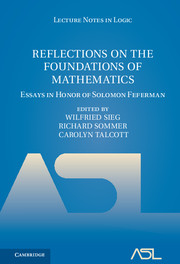Book contents
- Frontmatter
- Preface
- Contents
- PART I PROOF THEORETIC ANALYSIS
- PART II LOGIC AND COMPUTATION
- PART III APPLICATIVE AND SELF-APPLICATIVE THEORIES
- On extensionality, uniformity and comprehension in the theories of operations and classes
- The proof-theoretic analysis of the Suslin operator in applicative theories
- Feferman-Landin Logic
- Explicit mathematics with monotone inductive definitions: A survey
- PART IV PHILOSOPHY OF MODERN MATHEMATICAL AND LOGICAL THOUGHT
- Symposium program
- References
Feferman-Landin Logic
from PART III - APPLICATIVE AND SELF-APPLICATIVE THEORIES
Published online by Cambridge University Press: 31 March 2017
- Frontmatter
- Preface
- Contents
- PART I PROOF THEORETIC ANALYSIS
- PART II LOGIC AND COMPUTATION
- PART III APPLICATIVE AND SELF-APPLICATIVE THEORIES
- On extensionality, uniformity and comprehension in the theories of operations and classes
- The proof-theoretic analysis of the Suslin operator in applicative theories
- Feferman-Landin Logic
- Explicit mathematics with monotone inductive definitions: A survey
- PART IV PHILOSOPHY OF MODERN MATHEMATICAL AND LOGICAL THOUGHT
- Symposium program
- References
Summary
Abstract This paper presents a logic based on Feferman's Variable Type Theories for reasoning about programs written in a class of imperative functional languages called Landinesque languages.
To Solomon Feferman on the occasion of his 70th Birthday with much gratitude.
Historical background Feferman-Landin Logic is so named because of the influence that the work of both Feferman and Landin has had on our work. Of particular relevance are two key ideas:
Landin's idea: a programming language can be thought of as the lambda calculus augmented by operations on the basic data, as well as computational environment. We call such languages Landinesque languages.
Feferman's idea: to formalize constructive mathematics in 2-sorted classical theories called variable type theories. In these theories both functions and data are objects of discourse in a first order setting, as are collections of such things.
Both authors were PhD students of Solomon Feferman in the early 1980's where, under his influence,we began the research programleading to thework that this paper will report on. Both the theories used by Feferman, and his approach to formalizing constructive mathematics seemed very natural and we felt that this approach should also work for developing formal systems for reasoning about programs.
The first step in such an endeavor is to develop the mathematical semantics of the programs of interest. Our focus has been on reasoning about non-functional primitives. Together we have studied lambda calculus augmented by operations formanipulating control [39], manipulating memory [29], and for communicating asynchronously in an open distributed environment [2]. In each casewe developed an operational semantics based solely on syntactic entities,and studied the natural operational equivalence generated by that semantics (operational equivalence meaning being equi-defined in all closing contexts). Crucial in such work is the ability to simplify the criteria for operational equivalence to some form of context lemma a la Robin Milner [31] to avoid the complexity of reasoning about arbitrary program contexts. In both the case of memory, and control, we have established such simplifications now known in the literature as CIU theorems (Closed Instantiations of Uses). The case for communicating asynchronously in an open distributed environment remains open.
- Type
- Chapter
- Information
- Reflections on the Foundations of MathematicsEssays in Honor of Solomon Feferman, pp. 293 - 328Publisher: Cambridge University PressPrint publication year: 2002
References
- 1
- Cited by



